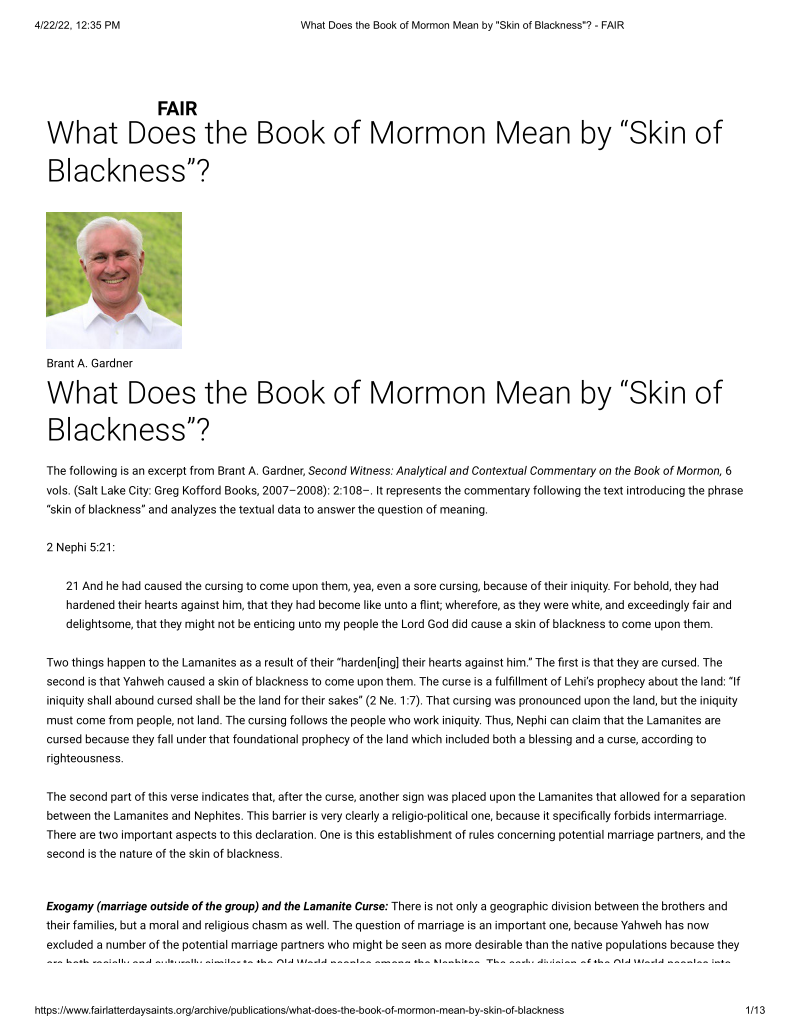Brant A. Gardner argues that black skin in the Book of Mormon is metaphorical for out-groups.
- Type
- Website
- Source
- Brant A. Gardner LDS
- Hearsay
- Direct
- Reference
Brant A. Gardner, Second Witness: Analytical and Contextual Commentary on the Book of Mormon, 6 vols.(Salt Lake City: Greg Kofford Books, 2007), 2:108, reprinted at FairMormon website, accessed on April 22, 2022
- Scribe/Publisher
- Greg Kofford Books
- People
- Brant A. Gardner
- Audience
- Reading Public
- Transcription
I conclude that the association between skin and white/black is metaphoric, not intended to indicate pigmentation. Douglas Campbell, a professor of computer science at Brigham Young University, examined the textual uses of “white” in the Book of Mormon and concludes that the term is used metaphorically for purity and/or cleanliness. The metaphorical use of color terms echoes that of the Bible.
. . . .Why should a metaphor of color describe the skin or face if it does not refer to pigmentation? Why should metaphorical righteousness/unrighteousness be manifest in a “color” of skin? It is not significantly different from ascribing emotion to the heart, which is an organ having no biological relevance to emotions at all. Underlying these biblical and Book of Mormon metaphors are the assumptions of the collectivist social world. Malina and Neyrey describe this mentality for the ancient Mediterranean cultures: “Human beings are distinctive in that they exhibit a considerable range of physical shapes, hues, and structures. Yet as in the case with other animate beings, the shape of the individual human more than adequately reveals the type of personality he or she can be and explains his or her ‘nature.’ For humans, too, anatomical form determines behavior and reveals the nature of the human being in question.”
In the Mediterranean world the understanding of personality through physical characteristics was called physiognomics. . . .Such an idea runs counter to modern constructions of human beings as individuals, but it reflects accurately, I believe, the different social view of Nephi’s world. Malina and Neyrey continue: “When considering a person, the ancients thought that there was really nothing inside that did not register on the outside.” In this conception of humanity, the skin or face would be the logical location for spiritual characteristics to register. Even metaphorically, the skin and face were legitimate locations for the “display” of these spiritual characteristics.
. . . .The “skin of blackness” was certainly intended to be a pejorative term, but it was not a physical description. Modern readers may be uncomfortable with Nephite racial prejudices, but they existed. They were not, however, based on skin color as has been part of the more modern U.S. culture. Nephite prejudices were developed on distinctions more common to the ancient world and used reasons other than pigmentation.
- Citations in Mormonr Qnas
The B. H. Roberts Foundation is not owned by, operated by, or affiliated with the Church of Jesus Christ of Latter-day Saints.

